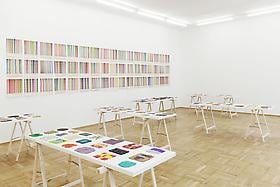
Unlike the minimalists of the 1960s, who tried to make something completely unprecedented, a “specific object” that was neither a painting nor a sculpture, I am interested in making objects that maintain the properties of both painting and sculpture: structure and support, flow and movement, color and surface, repetition and interval.
“Feelies” are image-objects made of plasticine and polymer clays. The title references works of the same name by American potter Rose Cabat, the Abstract American painter Paul Feeley and the 1980’s underground rock band The Feelies. I have always been interested in a non-rigid formal language, in the improvisational and situational. Things piled up, draped, lying on the floor, leaning against the wall. Fallen paintings. Serial and variable arrangements. As opposed to the orthogonal, erect, vertical and fixed.
Inspired by Leo Steinberg’s essay on the “Flatbed Picture Plane” (Artforum, March 1972) I remain very attracted to the idea that these works are collections, accumulations of things on a horizontal surface. You can collect anything on a flat surface and it stays there. I think that’s where the improvisational comes in. The basic insight of the Steinberg essay, that the work no longer alludes to some sort of vertical window onto the world, remains important to me: the very simple idea of operating by a process of accumulation on a horizontal receptor surface, whether it is dyed fabric on the floor or the plasticine works I make that sit on tabletops.
The attention on making as opposed to seeing is crucial in my installation. Unfired and still malleable, the polymer and plasticine clay panels present a narrative built of compositional impulse. The work is radically provisional. The order is not fixed, therefore the work can never be permanent. There are some formal relationships to abstract painting of the past, but because this work exists in the moment, it can always be changed. It has a sense of immediacy, as opposed to the durability and permanence that always seems to me to be signified in painting. There is a focus on possibility and process as opposed to an end point. I think of it as automatic abstraction, a negative abstraction, more open, based on chance, creating order within even haphazard circumstance.